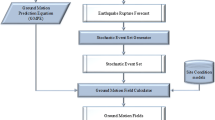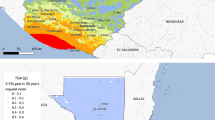Abstract
The spatial resolution of exposure data has a substantial impact on the accuracy and reliability of seismic risk estimates. While several studies have investigated the influence of the geographical detail of urban exposure data in earthquake loss models, there is also a need to understand its implications at the regional scale. This study investigates the effects of exposure resolution on the European loss model and its influence on the resulting loss estimates by simulating dozens of exposure and site models (630 models) representing a wide range of assumptions related to the geo-resolution of the exposed asset locations and the associated site conditions. Losses are examined in terms of portfolio average annual loss (AAL) and return period losses at national and sub-national levels. The results indicate that neglecting the uncertainty related to asset locations and their associated site conditions within an exposure model can introduce significant bias to the risk results. The results also demonstrate that disaggregating exposure to a grid or weighting/relocating exposure locations and site properties using a density map of the built areas can improve the accuracy of the estimated losses.














Similar content being viewed by others
Availability of data and material
The following GitLab repository contains the residential exposure data used herein: https://gitlab.seismo.ethz.ch/efehr/esrm20_exposure/-/tree/master/_exposure_models
Notes
Note that the Exposure Disaggregation Tool uses WorldPop population (www.worldpop.org) by default, but it supports other raster datasets including the GHS built-density layer used herein available for download at: https://gitlab.seismo.ethz.ch/efehr/esrm20_exposure/-/tree/master/spatial_disaggregation.
References
Allen TI, Wald DJ (2009) On the use of high-resolution topographic data as a proxy for seismic site conditions (VS30). Bull Seismol Soc Am 99:935–943. https://doi.org/10.1785/0120080255
Bal IE, Bommer JJ, Stafford PJ, Crowley H, Pinho R (2010) The Influence of Geographical Resolution of Urban Exposure Data in an Earthquake Loss Model for Istanbul. Earthq Spectra 26:619–634. https://doi.org/10.1193/1.3459127
Bazzurro P, Park J (2007) The effects of portfolio manipulation on earthquake portfolio loss estimates. In: Proceedings of the 10th international conference on applications of statistics and probability in civil engineering. Tokyo, Japan
Silva V, Brzev S, Scawthorn C, Yepes-Estrada C, Dabbeek J, Crowley H (2021) A building classification system for multi-hazard risk assessment. Int J Disaster Risk Sci (Submitted)
Crowley H (2014) Earthquake risk assessment: present shortcomings and future directions. Geotech Geol Earthq Eng 34:515–532. https://doi.org/10.1007/978-3-319-07118-3_16
Crowley H, Rodrigues D, Silva V, Despotaki V, Martins L, Romão X, Castro J, Pereira N, et al (2019) The European Seismic Risk Model 2020 (ESRM 2020). In: 2nd International Conference on Natural Hazards & Infrastructure (CONHIC 2019). Chania, Greece
Crowley H, Despotaki V, Rodrigues D, Silva V, Toma-Danila D, Riga E, Karatzetzou A, Fotopoulou S et al (2020a) Exposure model for European seismic risk assessment. Earthq Spectra. https://doi.org/10.1177/8755293020919429
Crowley H, Weatherill G, Riga E, Pitilakis K, Roullé A, Tourlière B, Lemoine A, Gracianne Hidalgo C (2020b) D26.4 Methods for estimating site effects in risk assessments. SERA Project Deliverable. Available from: http://www.sera-eu.org/en/Dissemination/deliverables/
Crowley H, Silva V, Martins L, Romão X, Pereira N (2021) Open Models and Software for Assessing the Vulnerability of the European Building Stock. In: 8th International Conference on Computational Methods in Structural Dynamics and Earthquake Engineering (COMPDYN 2021). Athens, Greece
Dabbeek J, Silva V (2020) Modeling the residential building stock in the Middle East for multi-hazard risk assessment. Nat Hazards 100:781–810. https://doi.org/10.1007/s11069-019-03842-7
Dabbeek J, Silva V, Galasso C, Smith A (2020) Probabilistic earthquake and flood loss assessment in the Middle East. Int J Disaster Risk Reduct 49:101662. https://doi.org/10.1016/j.ijdrr.2020.101662
DeBock DJ, Liel AB (2015) A comparative evaluation of probabilistic regional seismic loss assessment methods using scenario case studies. J Earthq Eng 19:905–937. https://doi.org/10.1080/13632469.2015.1015754
Fayjaloun R, Negulescu C, Roullé A, Auclair S, Gehl P, Faravelli M (2021) Sensitivity of earthquake damage estimation to the input data (soil characterization maps and building exposure): case study in the luchon valley. France 11:249. https://doi.org/10.3390/GEOSCIENCES11060249
Gomez-Zapata JC, Brinckmann N, Harig S, Zafrir R, Pittore M, Cotton F, Babeyko A (2021) Variable-resolution building exposure modelling for earthquake and tsunami scenario-based risk assessment An application case in Lima, Peru. Nat Hazards Earth Syst Sci Discuss. https://doi.org/10.5194/NHESS-2021-70
Kotha SR, Weatherill G, Bindi D, Cotton F (2020) A regionally-adaptable ground-motion model for shallow crustal earthquakes in Europe. Bull Earthq Eng 18:4091–4125. https://doi.org/10.1007/s10518-020-00869-1
Martins L, Silva V (2020) Development of a fragility and vulnerability model for global seismic risk analyses. Bull Earthq Eng. https://doi.org/10.1007/s10518-020-00885-1
Pagani M, Monelli D, Weatherill G, Danciu L, Crowley H, Silva V, Henshaw P, Butler L et al (2014) Openquake engine: an open hazard (and risk) software for the global earthquake model. Seismol Res Lett 85:692–702. https://doi.org/10.1785/0220130087
Pesaresi M, Ehrilch D, Florczyk AJ, Freire S, Julea A, Kemper T, Soille P, Syrris V (2015) GHS built-up grid, derived from Landsat, multitemporal (1975, 1990, 2000, 2014). In: Eur. Comm. Jt. Res. Cent. (JRC), . http://data.europa.eu/89h/jrc-ghsl-ghs_built_ldsmt_globe_r2015b. Accessed 24 Apr 2019
Pittore M, Haas M, Silva V (2020) Variable resolution probabilistic modeling of residential exposure and vulnerability for risk applications. Earthq Spectra 36:321–344. https://doi.org/10.1177/8755293020951582
Scheingraber C, Käser MA (2019) The impact of portfolio location uncertainty on probabilistic seismic risk analysis. Risk Anal 39:695–712. https://doi.org/10.1111/risa.13176
Silva V (2019) Uncertainty and correlation in seismic vulnerability functions of building classes. Earthq Spectra 35:1515–1539. https://doi.org/10.1193/013018EQS031M
Silva V, Crowley H, Pagani M, Monelli D, Pinho R (2014) Development of the openquake engine, the global earthquake model’s open-source software for seismic risk assessment. Nat Hazards 72:1409–1427. https://doi.org/10.1007/s11069-013-0618-x
Sousa L, Silva V, Bazzurro P (2017) Using open-access data in the development of exposure data sets of industrial buildings for earthquake risk modeling. Earthq Spectra 33:63–84. https://doi.org/10.1193/020316eqs027m
Stafford PJ (2012) Evaluation of structural performance in the immediate aftermath of an earthquake: a case study of the 2011 Christchurch earthquake. Int J Forensic Eng 1:58. https://doi.org/10.1504/ijfe.2012.047447
Wald DJ, Allen TI (2007) Topographic slope as a proxy for seismic site conditions and amplification. Bull Seismol Soc Am 97:1379–1395. https://doi.org/10.1785/0120060267
Weatherill G, Cotton F (2020) A ground motion logic tree for seismic hazard analysis in the stable cratonic region of Europe: regionalisation, model selection and development of a scaled backbone approach. Bull Earthq Eng 18:6119–6148. https://doi.org/10.1007/s10518-020-00940-x
Weatherill G, Kotha SR, Cotton F (2020) A regionally-adaptable “scaled backbone” ground motion logic tree for shallow seismicity in Europe: application to the 2020 European seismic hazard model. Bull Earthq Eng 18:5087–5117. https://doi.org/10.1007/s10518-020-00899-9
Woessner J, Laurentiu D, Giardini D, Crowley H, Cotton F, Grünthal G, Valensise G, Arvidsson R et al (2015) The 2013 European Seismic Hazard Model: key components and results. Bull Earthq Eng 13:3553–3596. https://doi.org/10.1007/s10518-015-9795-1
Funding
The work presented herein has received funding from the European Union’s Horizon 2020 research and innovation program through the research projects (1) “SERA” Seismology and Earthquake Engineering Research Infrastructure Alliance for Europe, under Grant agreement No. 730900 and (2) “RISE” Real-time Earthquake Risk Reduction for a Resilient Europe, under grant agreement No. 821115.
Author information
Authors and Affiliations
Corresponding author
Ethics declarations
Conflict of interest
Not applicable.
Code availability
All the workflows described in this study can be readily configured to allow risk modellers to explore these approaches themselves using a free and open set of tools: Exposure Disaggregation Tool (https://github.com/GEMScienceTools/spatial-disaggregation) and Site Preparation Tool (https://gitlab.seismo.ethz.ch/efehr/esrm20_sitemodel).
Additional information
Publisher's Note
Springer Nature remains neutral with regard to jurisdictional claims in published maps and institutional affiliations.
Appendix
Appendix
This appendix provides the list of 35 countries and the available administrative level used in the analyses (see Table 3). Note that the highest resolution for each country is given by the highest resolution at which the residential exposure data is originally made available. Lower levels of resolution have been produced by aggregating the data at lower administrative levels using available shapefiles.
Rights and permissions
About this article
Cite this article
Dabbeek, J., Crowley, H., Silva, V. et al. Impact of exposure spatial resolution on seismic loss estimates in regional portfolios. Bull Earthquake Eng 19, 5819–5841 (2021). https://doi.org/10.1007/s10518-021-01194-x
Received:
Accepted:
Published:
Issue Date:
DOI: https://doi.org/10.1007/s10518-021-01194-x




